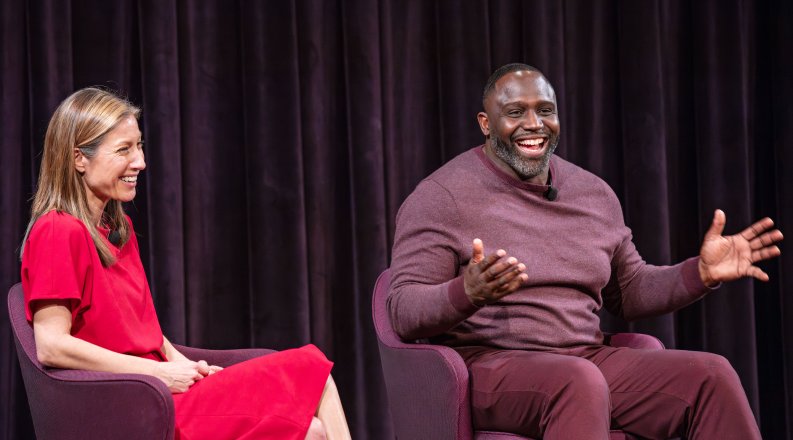Educational psychology, science education, identity development and multimedia learning are Old Dominion University professor Joanna Garner’s specialties. These concepts took shape in the form of “Change Your Game | Cambia Tu Juego,” an exhibition that opened in the Jerome and Dorothy Lemelson Hall of Invention at the Smithsonian National Museum of American History in Washington, D.C., on March 15.
Garner, executive director of The Center for Educational Partnerships at ODU, worked on the project for five years with a multidisciplinary team of researchers, curators, historians and designers to create the exhibit which examines the intersection of sports and innovation.
“About 10 years ago, I began to seriously think about how we can use museum exhibitions more effectively as learning environments where visitors, whether they're students or adults, can learn content and can also see the world and themselves differently because of those visits,” she said.
Around that same time, Garner began a collaboration with Avi Kaplan, a professor of educational psychology at the College of Education and Human Development at Temple University in Philadelphia. Their theories regarding identity exploration, along with projects at the Barry Art Museum at ODU and the Wagner Free Institute of Science in Philadelphia, caught the eye of curators at the Lemelson Center for the Study of Invention and Innovation, who envisioned a multimedia exhibition to explore how sports have evolved through the innovations of athletes, inventors and technologists.
“The Lemelson Center, which is housed within NMAH, wanted to develop an exhibition that would showcase the connections between sports and invention including the ways that invention and innovation have changed sports to be more competitive, more inclusive and more fair,” Garner said. “They also wanted the exhibition to help diverse visitors to see themselves as being inventive, not just in sports, but in their daily lives. So, this was a novel approach of using museum content, artifacts, stories and the inventors themselves.”
Garner helped acquire a $1.4 million Advancing Informal Science Learning grant from the National Science Foundation to move forward with the project. In 2020, around 50 people from teams including the Lemelson Center, the National Museum of American History and ROTO, an Ohio-based exhibition design firm, began building it.
“As researchers, we combined our theoretical model of identity and the design principles that we have for promoting identity exploration with specific strategies that we had already tested in informal learning settings,” Garner said.
“Working with the curators and designers, we all came to share this common language and common framework. Then, with the theory of design principles and strategies in mind, we put these into action to make them not just abstract ideas, but to actually create concrete components of the exhibition, including selected main ideas to present to the visitors describing specific inventive strategies that anyone can use.”
The result is a 3,500 square-foot exhibition featuring more than 60 sports technology inventions. It’s divided into six areas of exploration including Starting Line, Competitive Edge, Health and Safety, Fairness and Accuracy, Fun and Accessibility and End Zone.
Garner said the bilingual exhibition is an interactive experience thanks to videos and touchscreen activities that allow visitors to practice being inventive. It also is set to energizing music “that makes people feel like they are entering a space that is filled with possibilities.”
Among the artifacts is an early iteration of the sports bra from the 1970s; a camera used by the U.S. Open during the pandemic to automate line calls; Gatorade sports beverage; and prostheses that allow athletes with amputations to compete in sports.
Another featured invention is Crash Cloud, a foam padding product that was created to lessen concussive head trauma in athletes. It is produced by Windpact, a technology company founded by former National Football League player Shawn Springs.
Springs, a native of Williamsburg, conceived of the product after discovering that helmet technology had changed little from the days when his father played in the NFL. Additionally, he’d witnessed the effectiveness of the material in child car seats when his family was in a car accident. Those two separate realizations led him to develop Crash Cloud.
“Shawn's story is important because it demonstrates this motivation of wanting to keep people safe, of making sports and daily life more safe,” Garner said. “He looked around in the world, recognized problems, and used what he knew in one area of life to solve problems in a different area of life, which is a very inventive strategy that we can all use.”
“He also values teamwork, so he encourages his team of technologists and engineers to work together and to embrace failure, to keep trying and be persistent. Those are elements to invention and innovation that we can also use in our everyday lives. So, he has a solution-oriented outlook on life and strong motivations to continue as an entrepreneur and inventor.”
As the exhibit began to take shape, its original title, “Game Changers,” didn’t quite fit as the team realized that it alluded more to the high-level inventors rather than to the general public. Instead, “Change Your Game,” Garner said, invited the museum goer to participate in the conversation and apply the principles of invention to their lives.
In the End Zone, the final section of the exhibit, visitors view ideas for the inventions of others. They are also encouraged to discover their own “inventive identity” by tapping into their problem-solving and critical thinking skills to add their own idea to the project.
“There's so many examples of the public's inventiveness and I think one of the wonderful things about this exhibition is that it removes those barriers to people thinking of themselves as being inventive and it also allows them to share their inventive ideas,” Garner said.
Top photo: Joanna Garner, executive director of The Center for Educational Partnerships at Old Dominion University, talks with Shawn Springs, founder and CEO of technology company Windpact and a former NFL player, during the opening week of the “Change Your Game | Cambia Tu Juego” exhibition at the Lemelson Center for the Study of Invention and Innovation at the Smithsonian Institution in Washington, D.C. Photo Credit: Smithsonian photo by Jaclyn Nash




